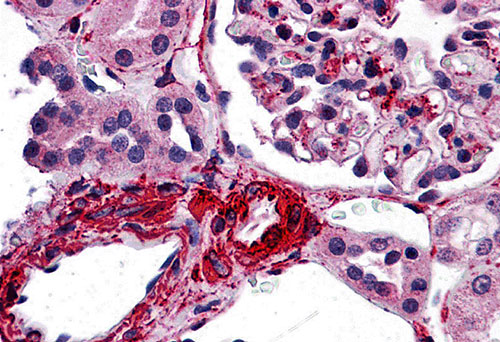CARMA3 Antibody
- SPECIFICATION
- CITATIONS
- PROTOCOLS
- BACKGROUND

Application
| IHC-P, E |
|---|---|
| Primary Accession | Q9BWT7 |
| Other Accession | NP_055365, 51093861 |
| Reactivity | Human |
| Host | Rabbit |
| Clonality | Polyclonal |
| Isotype | IgG |
| Calculated MW | 115931 Da |
| Application Notes | CARMA3 antibody can be used for detection of CARMA3 by immunohistochemistry at 5 µg/mL. |
| Gene ID | 29775 |
|---|---|
| Other Names | CARMA3 Antibody: BIMP1, CARMA3, Caspase recruitment domain-containing protein 10, CARD-containing MAGUK protein 3, Carma 3, caspase recruitment domain family, member 10 |
| Target/Specificity | CARD10; CARMA3 antibody is human specific. At least three isoforms of CARMA3 are known to exist; this antibody will only detect isoform 1. CARMA3 antibody is predicted not to cross-react with other CARMA proteins. |
| Reconstitution & Storage | CARMA3 antibody can be stored at 4℃ for three months and -20℃, stable for up to one year. As with all antibodies care should be taken to avoid repeated freeze thaw cycles. Antibodies should not be exposed to prolonged high temperatures. |
| Precautions | CARMA3 Antibody is for research use only and not for use in diagnostic or therapeutic procedures. |
| Name | CARD10 |
|---|---|
| Synonyms | CARMA3 |
| Function | Scaffold protein that plays an important role in mediating the activation of NF-kappa-B via BCL10 or EGFR. |
| Cellular Location | Cytoplasm. |
| Tissue Location | Detected in adult heart, kidney and liver; lower levels in intestine, placenta, muscle and lung. Also found in fetal lung, liver and kidney |

Thousands of laboratories across the world have published research that depended on the performance of antibodies from Abcepta to advance their research. Check out links to articles that cite our products in major peer-reviewed journals, organized by research category.
info@abcepta.com, and receive a free "I Love Antibodies" mug.
Provided below are standard protocols that you may find useful for product applications.
Background
CARMA3 Antibody: CARMA proteins belong to the membrane-associated guanylate kinase-like (MAGUK) family of proteins that can function as molecular scaffolds that assist assembly of signal transduction molecules. CARMA1, CARMA2, and CARMA3 share high degrees of sequence and functional homology, but their tissue-specific distribution suggests that they serve distinct biological functions in different cell types. As with CARMA1, the CARD domain of CARMA3 has been shown to specifically interact with BCL10, a protein known to function as a positive regulator of cell apoptosis and NF-κB activation. When expressed in cells, this protein binds to BCL10 and activates NF-κB Recent experiments have shown that CARMA3 is required for EGF-induced NF-κB activation and contributes to tumor growth in vivo, suggesting that CARMA3 may serve as a new therapeutic target for the treatment of EGFR-driven tumors.
References
Fanning AS and Anderson JM. Protein modules as organizers of membrane structure. Curr. Opin. Cell Biol. 1999; 11:432-9.
Gaide O, Martinon F, Michau O, et al. Carma1, 1 CARD-containing binding partner of Bcl10, induces Bcl10 phosphorylation and NF-kappa B activation. FEBS Lett. 2001; 496:121-7.
Wang L, Guo Y, Huang WJ, et al. Card10 is a novel caspase recruitment domain/membrane-associated guanylate kinase family member that interacts with BCL10 and activates NF-kappaB. J. Biol. Chem. 2001; 276:21405-9.
Jiang T, Grabiner B, Zhu Y, et al. CARMA3 is crucial for EGFR-induced activation of NF-kappaB and tumor progression. Cancer Res. 2011; 71:2183-92.
If you have used an Abcepta product and would like to share how it has performed, please click on the "Submit Review" button and provide the requested information. Our staff will examine and post your review and contact you if needed.
If you have any additional inquiries please email technical services at tech@abcepta.com.













 Foundational characteristics of cancer include proliferation, angiogenesis, migration, evasion of apoptosis, and cellular immortality. Find key markers for these cellular processes and antibodies to detect them.
Foundational characteristics of cancer include proliferation, angiogenesis, migration, evasion of apoptosis, and cellular immortality. Find key markers for these cellular processes and antibodies to detect them. The SUMOplot™ Analysis Program predicts and scores sumoylation sites in your protein. SUMOylation is a post-translational modification involved in various cellular processes, such as nuclear-cytosolic transport, transcriptional regulation, apoptosis, protein stability, response to stress, and progression through the cell cycle.
The SUMOplot™ Analysis Program predicts and scores sumoylation sites in your protein. SUMOylation is a post-translational modification involved in various cellular processes, such as nuclear-cytosolic transport, transcriptional regulation, apoptosis, protein stability, response to stress, and progression through the cell cycle. The Autophagy Receptor Motif Plotter predicts and scores autophagy receptor binding sites in your protein. Identifying proteins connected to this pathway is critical to understanding the role of autophagy in physiological as well as pathological processes such as development, differentiation, neurodegenerative diseases, stress, infection, and cancer.
The Autophagy Receptor Motif Plotter predicts and scores autophagy receptor binding sites in your protein. Identifying proteins connected to this pathway is critical to understanding the role of autophagy in physiological as well as pathological processes such as development, differentiation, neurodegenerative diseases, stress, infection, and cancer.


